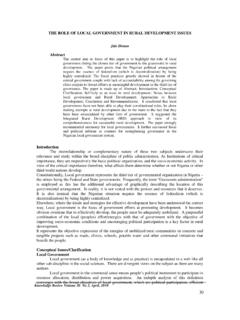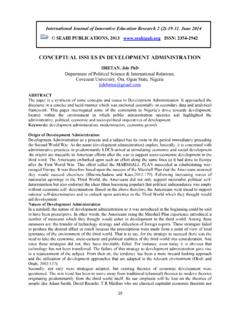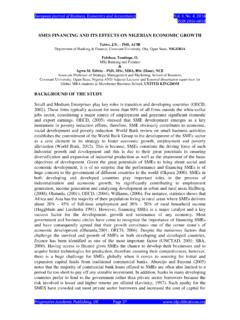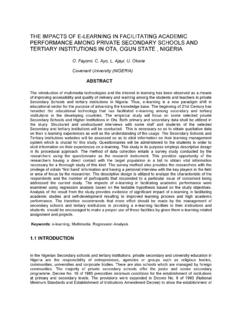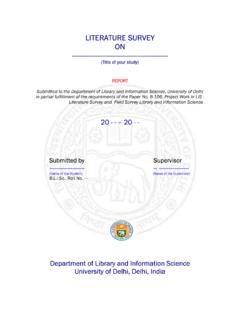Transcription of AJAYI AYOBAMI ELIZABETH - Covenant University …
1 1 FOREIGN AID AND ECONOMIC DEVELOPMENT IN SUB SAHARAN AFRICA: THE ROLE OF INSTITUTIONS (1996-2010) AJAYI AYOBAMI ELIZABETH Research Project Department of Economics, Covenant University , Ota, Ogun State 2013 2 TABLE OF CONTENTS Certification ii Dedication iii Acknowledgements iv Table of contents vi List of Tables ix Abstract x chapter 1.
2 INTRODUCTION Background to the Study 1 Statement of Problem 6 Research objectives 8 Research Questions 8 Research Hypothesis 9 Significance of study 9 Scope of study 9 Justification of Study 9 Limitations of study 10 Research methodology 10 Outline of Work 11 chapter 2: LITERATURE REVIEW Review of definitional issues 12 The concept of foreign aid 12 Advantages and Disadvantages of foreign aid 13 Forms of foreign aid 16 Organizations that give foreign aid 18 Trends of foreign aid in sub Saharan Africa 19.
3 Review of theoretical issues 21 : Review of Methodological and empirical issues 25 chapter 3: RESEARCH METHODOLOGY Introduction 35 Theoretical framework 35 Specification of Model 39 Description of variables 41 Sources of data and measurement 42 Technique of estimation 42 Method of analysis 44 chapter 4.
4 EMPIRICAL ANALYSES AND RESULTS Introduction 46 Data Analysis 46 3 Descriptive analysis 46 Econometric analysis 48 Findings and economic implications 55 Conclusions 56 chapter 5: SUMMARY AND CONCLUSION Summary 57 Policy recommendations 58 Conclusions 60 Limitations to study 60 Suggestions for further study 60 REFERENCES 61 APPENDIX 64 LIST OF TABLES Table 1: Descriptive statistics of variables Table 2: Ordinary pooled regression test Table 3.
5 Pair wise correlation test Table 4: Fixed effect regression test Table 5: Random effect regression test Table 6: Hauseman test Table 7: Systems Generalized Method of Moment 4 ABSTRACT This study examined the relationship between foreign aid and economic development in sub Saharan Africa. The study seeks to examine the role of institutions in aid effectiveness and economic development in Sub Saharan Africa. The study adopted a theoretical framework similar to the Endogenous or New Growth model, as well as; the system generalized method of moments (GMM) technique of estimation was adopted in order to overcome the challenge of endogeneity perceived in the institutions variables and Aid growth argument. It was observed that foreign aid significantly influence Real GDP Per Capita (the proxy for economic development) in Sub Saharan Africa. Also, variables like gross fixed capital formation, rule of law, control of corruption (which are proxy for institutions) and Human capital had a significant effect on Economic development in sub Saharan Africa while labour had no significant effect on economic development in Sub Saharan Africa.
6 5 chapter ONE INTRODUCTION Background To Study Most African countries are characterized by massive poverty, high death rate, slow GDP growth, high population growth rate and increased income inequality, increased absolute poverty rate, low educational standards, low human development index to mention a few. According to development statistics, in Africa, about billion people live on less than $1 a day and another billion people live on less than $2 a day. This is also a similar case in health as the mortality rate has sky rocketed over the years as declared according to the UNICEF who stated that more than 10 million children die each year from preventable disease such as malaria, polio to mention a few (Emmanuel, 2012; Ogundipe and Ogundipe, 2013). Another scenario in developing countries is that the child mortality rate remains more than 10 times higher than those found in the rich countries and this is as a result of diseases that can be treated easily like dehydration (Todaro and Smith, 2011).
7 In examining human capital development via education, Africa is in deteriorating conditions. The average child in sub Saharan Africa can expect to spend less than 5 years in school, without even considering absenteeism of teachers and lack of resources like books. This is in deep contrast with a child in Europe who is sure to get at least 12 years of schooling. Also, the education gender gap is especially great in developing countries in Africa, where female literacy rates can be less than half of men s in countries such as Nigeria, Mali, Guinea, Benin to mention a few. Sub Saharan Africa and even Africa as a whole have been seen to exhibit relatively low levels of income despite the fact that they are heavily populated. Sub Saharan Africa received 6 just two percent of total shares of Global income in the year 2008. According to Todaro (2011), In the case of income inequality and absolute poverty which is a major topic in development economics, the incidence of extreme poverty is very high as released by the World Bank s estimate that the share of the population living on less than $ per day is in sub Saharan Africa.
8 Population growth rate of developing countries especially in Africa continue to grow in leaps and bounds. From 1990 to 2008, population in the low income countries grew at an average of per year. The main issue is that there has been a case of heavy debt servicing and it has been observed that most funds in Africa go into servicing debts. (Todaro and Smith, 2011) Also, literature reviews have shown that during the 80s, averagely, in sub Saharan Africa, per capita income fell at an annual rate of percent. According to Bakare (2011), Per capita private consumption also dropped by percent, import volume rose at an annual rate of percent with export volume remaining constant with terms of trade falling by percent. Given the high population growth rate, annual real GDP per capita growth rate between 1981 and 1990 was which was contrary to East Asia s performance of GDP per capita growth rate of during that period.
9 Still the economic performance of Sub Saharan Africa did not improve in the early 90s as confirmed that between 1991 and 1993, real per capita GDP was annually. In 1994, it still remained negative at Luckily, in 1995, this became positive reaching which was still lower than the growth rate testified by East Asia. The World Bank classified 74% of the countries of SSA as low income economies while the United Nations Development Programme classified 79% of SSA as low human development countries. Lastly, according to World bank (1998), out of the 41 countries in the world classified as heavily 7 indebted countries by the World Bank and international monetary fund, 80% are in sub Saharan Africa (SSA) ( Bakare , 2011). From the above illustrations, it has been obvious that Africa (more specifically, sub Saharan Africa) cannot develop on their own and they need all the help they can get. As a result, foreign aid comes to foreplay.
10 Foreign aid can be defined as all resources- physical goods, skills, technical know-how, financial grants, or loans (at concessional rates) transferred by donors to recipients (Riddell 2007). According to the Development Assistance Committee (DAC) of the Organization for economic cooperation and development (OECD), foreign aid is defined as official development assistance (ODA). According to DAC, aid qualifies as ODA on three criteria: 1) It has to be undertaken by official agencies and flows have to go to developing country government 2) It has to have the promotion of economic development and welfare as its main objective, thus excluding military aid and private investment 3) It has to have a grant element of twenty five percent or more at a ten percent discount rate It was stated in some economic theories that capital formation was the basic problem of developing countries with Africa being one of them and so aid is important as it play a vital role in capital formation which is essential for economic growth.


